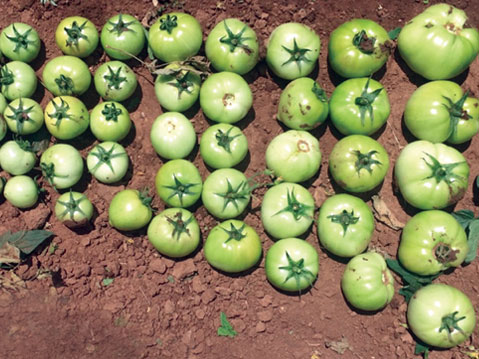The farm supplies tomatoes for canning and food industry processing. StandUp® was applied on a basis of 50% of the conventional fertilization scheme, followed by farmers in the area. This led to a 2.3% increase in yield over conventional fertilization scheme. Compared to completely untreated crop, the yield of crop treated with combination of 50% of conventional fertilizer and StandUp® was 43,86% higher. At the same time, the use of StandUp® with only half of the conventional fertilizer did not affect the levels of plant available nitrogen and phosphorus nutrients in the soil, compared to the conventional fertilization scheme. Fruit maturity and brix levels were similar in all tests.
Field trials were conducted in Greece on two precision farms that supply canning tomatoes for a large multi-national company. Tomatoes are grown under drip irrigation. Purpose of trials was to focus on yield, lower input costs, Brix levels and also on environmental benefits from reducing fertilizer by 50% and replacing with 10 liters/ha of StandUp®.

Trial reports are available on demand.
untreated crop
conventional inorganic fertilizer
50% StandUp® combined w. conventional fertilizer
untreated crop
conventional inorganic fertilizer
50% StandUp® combined w. conventional fertilizer
Experiment was designed to evaluate the effect of StandUp® and inorganic fertilization on the yield and quality of the produced can tomato (stem length, root length, stem / root dry weight, fresh stem / root mass), final yield and brix content.
Two applications of StandUp® at 5 liters/ha provided a similar tomato yield as 100% of the conventional fertilization scheme followed by farmer. The use of StandUp® with only half of the conventional fertilizer did not affect the levels of plant available nitrogen and phosphorus nutrients in the soil, compared to the conventional fertilization scheme. Fruit maturity and brix levels (4.8) were similar in all tests.
Crop yield for StandUp® treated area was of 100 tons/ha and equal to yield from rest of field that received full fertilizer treatment. Input costs were lower, and Brix levels were the same. The soil benefited from less fertilizer being applied, as did the environment through reduced leaching into freshwater resources or the atmosphere as a greenhouse gas.
Crop yield for StandUp® treated area was of 100 tons/ha and higher to yield from rest of field that received full fertilizer treatment. Part of this field which received 100% chemical fertilizer application was affected by rainwater flooding and produced significantly lower yield than the area treated with StandUp®. StandUp® helps to reduce compaction of soil and allow it to absorb more rain water.